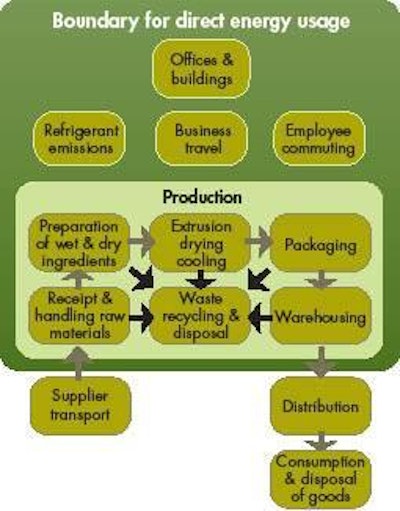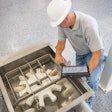
Very few people now dispute the fact of global warming, though there are lively debates about the rate of warming and how much of it is a direct result of mankind's activities. Many consumers, retailers and governments are expressing the need to do something now about global warming. In particular there is increasing pressure to reduce carbon footprints, the measure of the impact human activities have on the environment, in terms of the amount of greenhouse gases produced. This article will cover five steps for reducing carbon footprints:
- Understanding the issue.
- Calculating your carbon footprint.
- Weighing risks and benefits of a low carbon agenda.
- Focusing on manufacturing.
- Looking at the big picture.
The carbon footprint concept requires petfood manufacturers to analyze the total "carbon cost" of manufacturing in a way that goes well beyond direct energy costs.
Understanding the issue
Carbon dioxide (CO2 ) is recognized as the principal greenhouse gas. Without CO2 in the atmosphere the earth would be uninhabitable. The presence of just 0.037% of this gas in our atmosphere is responsible for the retention of infra-red heat that otherwise would be radiated out into space, leaving the earth as a ball of ice floating in a huge cold space.
Note that before the industrial revolution the average atmospheric concentration of CO2 was 0.028%, now it is 0.037%. Most scientists think that this increase in CO2, as well as other greenhouse gases, is creating a situation where an increasing amount of heat is being retained by the earth, leading to a net warming effect.
The industrial revolution created a sudden demand for energy that led to our use of fossil fuel sources such as coal, oil and natural gas. The carbon that was locked into these materials is being released as CO2 into the atmosphere. The earth can substantially buffer this releasea great majority of the released CO2 is absorbed by the oceans and vegetation. However, as the rate of CO2 release has increased in the last century, the earth's buffering capacity has not been able to keep up. Hence there is a global drive to decrease or offset carbon emissions.
Various governments and organizations have established plans that allow industries to offset their carbon emissions. This is achieved by investing in an accredited plan to buy carbon credits. Theoretically an organization can pay for the carbon it emits, or partially offset the amount of carbon it emits, by investing in an endeavor that reduces carbon emissions. Carbon offset endeavours include:
- Renewable energy;
- Energy efficiency;
- Methane capture; and
- Forestry.
Calculating your carbon footprint
Petfood companies need to calculate their carbon footprints before investing in either company changes or carbon offsets. To do so, use one of the many carbon footprint calculators available on the internet, for example www.carbonfootprint.com/calculator.aspx. The following information will need to be prepared in advance to carry out the calculation:
- Number of staff and sites;
- Annual fuel consumption in kilowatt hours;
- Amount of waste disposed to landfill and/or incinerated;
- Annual distance or fuel consumption of company owned vehicles, including gasoline, diesel, hybrid, LPG, electric and hydrogen;
- Annual business travel distance or fuel consumption of company vehicles;
- Annual business journeys taken by taxi or train;
- Annual number of flights;
- Annual number of hotel nights; and
- Annual commuting distances by staffcars, motorcycles, public transport.
After calculating the carbon footprint, the next step is to break down your company's wishes into manageable parts so that action plans can be formulated and implemented (see Figure 1).
Weighing risks and benefits
Petfood companies need to weigh the risks and benefits of adopting a low carbon agenda. Investments in technology can be expensive, but can also reduce some costs. To make good decisions, companies will need an overview of the genuine cost efficiency benefits and the positive impacts on sales, reputaion, trust and long term sustainability.
Focusing on manufacturing
The biggest energy user in a petfood company is the manufacturing plant. It is here that the biggest savings can be quickly made, not always with the need for high capital investment. The use of process flow diagrams can assist with analysis and planning. Start by answering the following questions:
- What is the no-load power draw on all the motors?
- Are motors run for long periods with no product running? If so, why?
- Which motors would benefit from the use of inverters?
- What is the theoretical use of steam in the conditioner compared to actual?
- Do we pre-heat conditioning water?
- What benefit would pre-hydration of dry feed give us?
- What are air-flows, temperatures and humidities?
- Can we re-use process air?
- Is the dryer optimized?
- Are production rates maximized?
- How much start-up and shut-down waste is there and why?
- How is waste handled and why?
- Are we over-drying product?
- Can we handle ingredients in re-usable vs. disposable containers?
- Are we using extruder cooling water as boiler make-up water?
- Do we know exact energy cost for each product?
The big picture
As an integral part of the implementation strategy, there should be a strategy in place that presents clear and upfront information to customers through labeling, advertising and personal communication. Achievable targets should be established to reduce carbon footprints that give measurable objectives in terms of energy savings and compliance with targets.
Whether or not we agree with any or all of the issues related to global warming, it can only do our companies good to adopt a culture of minimized energy and waste. There is an opportunity to demonstrate to our customers and regulatory authorities that our companies follow practices of sustainability and ethical manufacture and are empathic with public perceptions and changing global issues.
.jpg?auto=format%2Ccompress&crop=faces&fit=crop&h=48&q=70&w=48)

















